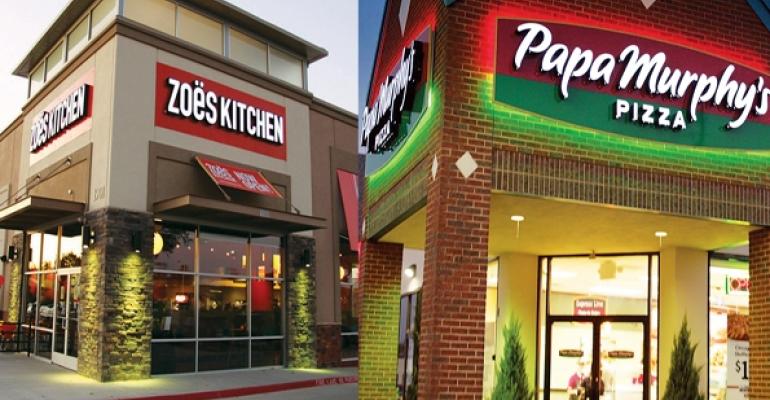Two restaurant initial public offerings were priced in recent weeks with decidedly different outcomes. Zoe’s Kitchen Inc. was hot. During the marketing of the deal, the expected price range was increased from $11 to $13 a share to $13 to $15 a share. The offering was priced at $15 a share – the high end of the revised range – and the stock closed at $24.72 its first day of trading, up 65 percent from the offering price. The stock has continued to trade in the mid-$20-a-share range since the offering.
The response to Papa Murphy’s Holdings Inc.’s IPO, priced just three weeks after Zoe’s, was more tepid. The initial filing price range was $11 to $13 a share, and the offering was priced at $11. On the first day of trading, the stock closed at $11.05, essentially flat with the offering price. More recently, the stock has traded below the offering price.
Why the very different results for these two financings? The most important reason is that the tone of the market changed dramatically in the short time between the Zoe’s pricing and Papa Murphy’s offering. During the week that Zoe’s came to market, there was strong demand for virtually every offering that was priced. Most were priced at the high ends of their filing ranges and traded up in the aftermarket.
RELATED
More from Steve Rockwell
• Lessons for fast casual from casual dining
• Private equity filling restaurant finance gap
• More opinions
NEWS FROM NRN
• Zoe’s Kitchen plans expansion after successful IPO
• Papa Murphy's shares rise modestly on public debut
• More Finance news
During the week of Papa Murphy’s offering, in contrast, several deals were withdrawn, and those that did price were priced at or below the low end of their filing ranges. In fact, 16 companies in a row priced their IPOs below the midpoint of their original filing ranges, including Papa Murphy’s – the longest streak in at least 15 years. There was no discernible difference in the macro environment over that three-week period to explain the weakness; it was probably due to psychological factors and investor fatigue after the completion of numerous IPOs over a long period of time.
Company-specific attributes also came into play. For example, a group of Papa Murphy’s franchisees filed a lawsuit after the IPO was in registration alleging a lack of disclosure regarding regional sales trends and excessive marketing fees. Regardless of the merits of the suit, it undoubtedly had some impact on investor demand for the IPO. There were no similar negative developments during Zoe’s IPO.
Zoe’s growth rate, in part because of its smaller base of units and sales, has been more rapid. For example, Zoe’s average annual growth rate of adjusted EBITDA for the last four years was 84.1 percent (from a very low base), compared with that of 10.2 percent for Papa Murphy’s. Average unit volumes over the last four years rose 7.4 percent annually for Zoe’s and 1.1 percent for Papa Murphy’s. Same-store sales growth has also been more robust for Zoe’s – 6.9 percent in 2013 compared with 2.8 percent for Papa Murphy’s.

Why do you think Zoe's has performed so well, while Papa Murphy's has seen a more tepid response? Join the conversation in the comments below.
As a result, the Zoe’s offering probably had stronger appeal to small-company aggressive-growth investors. It has been my experience that demand for smaller-restaurant IPOs is concentrated among small-cap aggressive-growth investors, resulting in a greater pool of demand for Zoe’s and contributing to its strong reception.
On the surface, Zoe’s also has more “white space” for expansion. With a little more than 100 units, there is the possibility of growing the company to many times its current size. Papa Murphy’s has approximately 1,400 domestic locations. While there remains opportunity for expansion, it is most likely more limited than for Zoe’s.
The competitive dynamics of each company’s market position also contribute to their respective expansion potentials. Zoe’s is the leading fast-casual operator of Mediterranean restaurants, and takes advantage of health and lifestyle trends. Papa Murphy’s is the leading take-and-bake pizza chain, but may be viewed as in competition with traditional pizza chains and grocery stores.
Based on information in their IPO prospectuses, both concepts have good unit level economics that support investing in growth. Zoe’s cash-on-cash return on investment is targeted to exceed 30 percent by the end of the third year. Papa Murphy’s lower cash-on-cash return of 20 percent is compensated for by a very low investment of $200,000.
There are a couple of conclusions to draw from these examples. The first is that the timing of an IPO really matters when it comes to creating demand that can lead to a high valuation. In just the few weeks between the two deals, the market cooled and the relative demand for Papa Murphy’s declined enough to affect its pricing. Second, fundamentals really do matter. Papa Murphy’s positioning, operating results and growth potential, while not quite as strong as Zoe’s, are excellent in their own rights. If they were not, its IPO would have been withdrawn – like many that were expected to be priced at about the same time.





